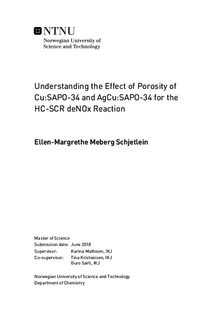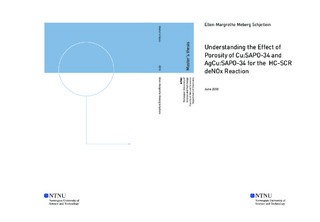| dc.description.abstract | This thesis is a continuation of another thesis written by Botne (2017)1. SAPO-34 with different porosity was ion-exchanged with copper and co-exchanged with copper and silver. The materials were tested for selective catalytic reduction (SCR) of NOx, with propene as reductant. An attempt was made to make samples with incorporated copper, with no success. The crystallinity of SAPO-34, Cu:SAPO-34, AgCu:SAPO-34 and CuSAPO-34 were verified with X-ray diffraction (XRD) and surface area and pore size were measured using Brunauer-Emmett-Teller (BET)- and Barett, Joyner and Halenda (BJH)- method. The metal content was detected with Inductively Coupled Plasma Mass Spectrometry (ICP-MS). The NOx conversion was measured using a Chemiluminecence NO/NOx analyser in both dry and wet feed.
Botne (2017)1 enlightened a known issue with structural collapse of SAPO-34, due to irreversible hydrolysis of Cu:SAPO-34 during the ion-exchange process.3 In this thesis. this was prevented by doing the ion-exchange in two steps. All of the samples but one was active in the deNOx reaction, and the sample which achieved the highest conversion was the conventional Cu:SAPO-34 in a dry feed, reaching a conversion of 70% at 375°C. The hierarchical and conventional Cu:SAPO-34 in a wet feed were very similar, with 58.3% versus 59.3% as maximum conversion, respectively. Between hierarchical and conventional AgCu:SAPO-34 in a dry feed, the difference was respectively 54.2% versus 16.1%. Comparing similar samples, the wet feed did not impact the conversions more than about 10 percentage points. All but one of the samples was active in a broader temperature-range than reported with similar samples by Botne, and in this study the highest conversions was reached at lower temperatures. | |

